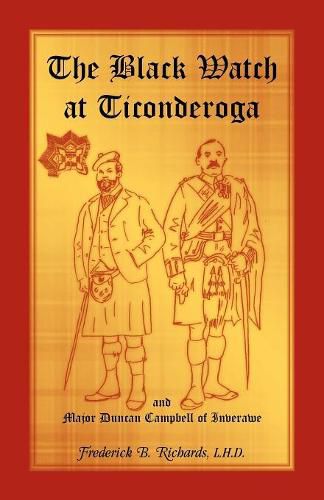Readings Newsletter
Become a Readings Member to make your shopping experience even easier.
Sign in or sign up for free!
You’re not far away from qualifying for FREE standard shipping within Australia
You’ve qualified for FREE standard shipping within Australia
The cart is loading…






This title is printed to order. This book may have been self-published. If so, we cannot guarantee the quality of the content. In the main most books will have gone through the editing process however some may not. We therefore suggest that you be aware of this before ordering this book. If in doubt check either the author or publisher’s details as we are unable to accept any returns unless they are faulty. Please contact us if you have any questions.
The Black Watch Regiment gained fame for its fearless charge during Major General James Abercrombie’s futile attack on Ticonderoga in 1758, in which more than half of the 1,000 Highlanders were killed or wounded in one of the most dramatic battles of the French and Indian War. At this battle, Major Duncan Campbell met his death, as foretold by a ghost several years earlier at his home at Inverawe, Scotland. The eerie legend is explained in this book, and was immortalized in Robert Louis Stevenson’s poem Ticonderoga. This small but comprehensive volume gives a history of the Black Watch Regiment from 1667. The Black Watch was also known as the 42nd Regiment of Foot, the Highlanders, the Royal Highlanders or Lord John Murray’s Highlanders. Included in this work is a family history of the Campbells of Inverawe. Appendices A-S give a wide variety of information: regimental and company rolls; principal campaigns, battles, etc.; British and Provincial Regiments at Ticonderoga, 1758 and 1759; and biographical sketches of thirty-one officers of 1758 (including Abercrombie, several Campbells, John Reid, James and Lord John Murray, and Thomas Stirling). Other appendices contain an original regimental list of the Black Watch; 1759 officers list; and references taken from Commissary Wilson’s Orderly Book. A bibliography and copy of references to be found in the Canadian Archives round out this volume. This excellent resource is brimming with hundreds of names, and contains a map by Thomas Jeffreys of The Plan of the Town and Fort of Carillon at Ticonderoga.
$9.00 standard shipping within Australia
FREE standard shipping within Australia for orders over $100.00
Express & International shipping calculated at checkout
This title is printed to order. This book may have been self-published. If so, we cannot guarantee the quality of the content. In the main most books will have gone through the editing process however some may not. We therefore suggest that you be aware of this before ordering this book. If in doubt check either the author or publisher’s details as we are unable to accept any returns unless they are faulty. Please contact us if you have any questions.
The Black Watch Regiment gained fame for its fearless charge during Major General James Abercrombie’s futile attack on Ticonderoga in 1758, in which more than half of the 1,000 Highlanders were killed or wounded in one of the most dramatic battles of the French and Indian War. At this battle, Major Duncan Campbell met his death, as foretold by a ghost several years earlier at his home at Inverawe, Scotland. The eerie legend is explained in this book, and was immortalized in Robert Louis Stevenson’s poem Ticonderoga. This small but comprehensive volume gives a history of the Black Watch Regiment from 1667. The Black Watch was also known as the 42nd Regiment of Foot, the Highlanders, the Royal Highlanders or Lord John Murray’s Highlanders. Included in this work is a family history of the Campbells of Inverawe. Appendices A-S give a wide variety of information: regimental and company rolls; principal campaigns, battles, etc.; British and Provincial Regiments at Ticonderoga, 1758 and 1759; and biographical sketches of thirty-one officers of 1758 (including Abercrombie, several Campbells, John Reid, James and Lord John Murray, and Thomas Stirling). Other appendices contain an original regimental list of the Black Watch; 1759 officers list; and references taken from Commissary Wilson’s Orderly Book. A bibliography and copy of references to be found in the Canadian Archives round out this volume. This excellent resource is brimming with hundreds of names, and contains a map by Thomas Jeffreys of The Plan of the Town and Fort of Carillon at Ticonderoga.